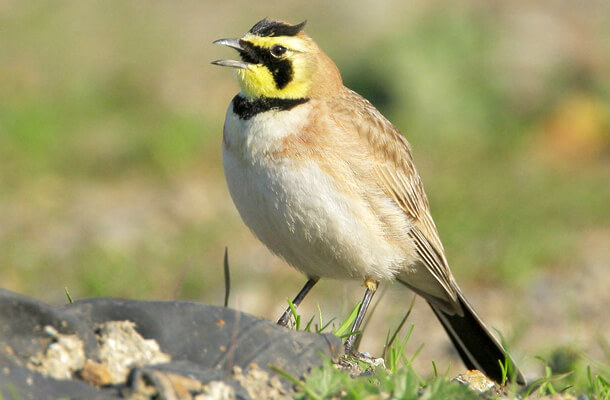Streaked Horned Lark Among Ten Species Imperiled by Pesticides, According to New Report
Media Contact: Jordan Rutter, Director of Public Relations, 202-888-7472 | jerutter@abcbirds.org
Expert Contacts: Steve Holmer, American Bird Conservancy, Vice President of Policy, Phone: 202-888-7490 | Email: sholmer@abcbirds.org
Derek Goldman, Endangered Species Coalition, Northern Rockies Representative, Phone: 406-721-3218 | Email: dgoldman@endangered.org

Most of the 2,000 remaining Streaked Horned Larks nest in the agricultural fields of Oregon's Willamette Valley, where pesticide use poses a serious threat. Photo by Tom Grey. Photos available for press download.
Washington, D.C., Oct. 30, 2019) Pesticides applied to lawns, gardens, and industrial agriculture operations are a major threat to imperiled wildlife, according to a new report released today. “Poisoned: 10 American Species Imperiled by Pesticides” details how domestic and commercial pesticides — including herbicides, insecticides, and rodenticides — are contributing to the decline of species both common and rare. One of these, the Streaked Horned Lark, numbers fewer than 2,000 and was listed as Threatened under the Endangered Species Act in 2013.
A rare subspecies of the widespread Horned Lark, this small, ground-nesting bird was historically found throughout the Pacific Northwest, from southwestern British Columbia to southwestern Oregon. Today, it has vanished from almost all of that range. Most of the remaining population nests in the agricultural fields of Oregon's Willamette Valley, where pesticide use poses a serious threat.
“Pesticides are a regular part of operations on many farms, including use of seeds treated with neonicotinoids,” says Bob Altman, renowned lark expert and former conservationist with American Bird Conservancy. “Ingestion of a single seed treated with neonicotinoids is enough to kill a bird.” Another threat is zinc phosphide, which is commonly used in the Willamette Valley for rodent control on farms and at airports. In 2014, four Streaked Horned Larks were found dead at the airport in Corvallis, Oregon; the gizzard of one of the birds tested positive for zinc phosphide. This substance is extremely toxic to birds and other animals, resulting in heart and kidney failure when ingested. “When it comes to Streaked Horned Lark, we can't afford to lose more individuals to pesticides – and multiple pesticides are widely used across its small remaining range.”
Pesticide impacts are felt across the web of life — from insects and birds to mammals. The Monarch butterfly, for instance, has declined by nearly 80 percent in the last two decades, largely due to eradication by herbicides of milkweed, the only food source for Monarch caterpillars. Similarly, the Crotch's Bumble Bee has paralleled the decline of many other native bees as a result of the use of neonicotinoids. Native bees are important pollinators, not only for wild plants but for agricultural crops as well.
The ten species featured in “Poisoned,” produced by the Endangered Species Coalition, are:
- California Red-legged Frog
- Chinook Salmon
- Crotch's Bumble Bee
- Indiana Bat
- Monarch butterfly
- Pink Mucket Pearly Mussel
- San Joaquin Kit Fox
- Northern Spotted Owl
- Salado Salamander
- Streaked Horned Lark
Endangered Species Coalition's member groups nominated species for the “Poisoned” report. A committee of distinguished scientists reviewed the nominations and decided which species should be included. Please see the full report, along with photos and additional species information.
The Endangered Species Coalition produces a “Top 10” report annually, focusing on a different theme each year. Previous years' reports are also available on the Coalition's website.
###
American Bird Conservancy is a nonprofit organization dedicated to conserving birds and their habitats throughout the Americas. With an emphasis on achieving results and working in partnership, we take on the greatest problems facing birds today, innovating and building on rapid advancements in science to halt extinctions, protect habitats, eliminate threats, and build capacity for bird conservation. Find us on abcbirds.org, Facebook, Instagram, and Twitter (@ABCbirds).


















































